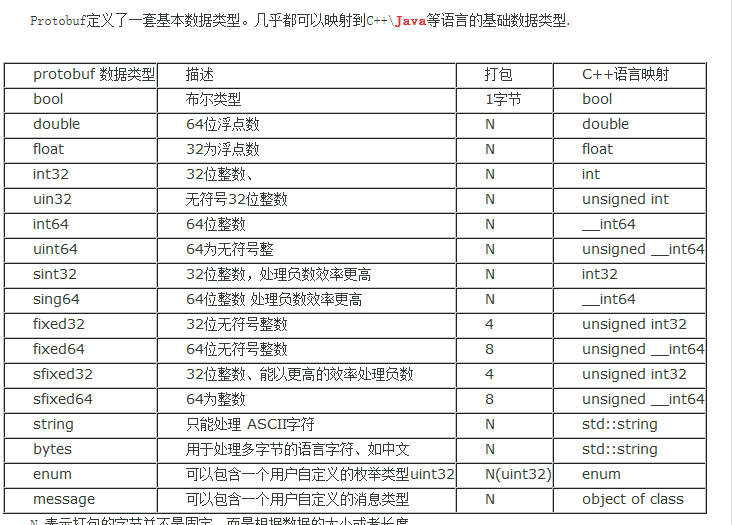.proto Type
| Notes | C++ Type | Java Type | |
| double | double | double | |
| float | float | float | |
| int32 | Uses variable-length encoding. Inefficient for encoding negative numbers – if your field is likely to have negative values, use sint32 instead. | int32 | int |
| int64 | Uses variable-length encoding. Inefficient for encoding negative numbers – if your field is likely to have negative values, use sint64 instead. | int64 | long |
| uint32 | Uses variable-length encoding. | uint32 | int |
| uint64 | Uses variable-length encoding. | uint64 | long |
| sint32 | Uses variable-length encoding. Signed int value. These more efficiently encode negative numbers than regular int32s. | int32 | int |
| sint64 | Uses variable-length encoding. Signed int value. These more efficiently encode negative numbers than regular int64s. | int64 | long |
| fixed32 | Always four bytes. More efficient than uint32 if values are often greater than 228. | uint32 | int |
| fixed64 | Always eight bytes. More efficient than uint64 if values are often greater than 256. | uint64 | long |
| sfixed32 | Always four bytes. | int32 | int |
| sfixed64 | Always eight bytes. | int64 | long |
| bool | bool | boolean | |
| string | A string must always contain UTF-8 encoded or 7-bit ASCII text. | string | String |
| bytes | May contain any arbitrary sequence of bytes. | string | ByteString |

public static Dictionary<string, string> MySqlToProbuffer = new Dictionary<string, string>()
{
{"varchar", "string"},
{"longtext", "string"},
{"text", "string"},
{"char", "string"},
{"mediumtext", "string"},
{"bigint", "int64"},
{"datetime", "int64"},
{"timestamp", "int64"},
{"int", "int32"},
{"tinyint", "int32"},
{"smallint", "int32"},
{"decimal", "double"},
{"double", "double"},
{"float", "float"},
{"bit", "bool"},
{"blob", "bytes"},
{"longblob", "bytes"},
{"varbinary", "bytes"},
{"binary", "bytes"}
};
public static Dictionary<string, string> ProbufferToJava = new Dictionary<string, string>()
{
{"string", "String"},
{"int32", "Integer"},
{"int64", "Long"},
{"double", "Double"},
{"float", "Float"},
{"bool", "Boolean"},
{"bytes", "ByteString"},
{"uint32", "Integer"},
{"uint64", "Long"},
{"sint32", "Integer"},
{"sint64", "Long"},
{"fixed32", "Integer"},
{"fixed64", "Long"},
{"sfixed32", "Integer"},
{"sfixed64", "Long"},
};